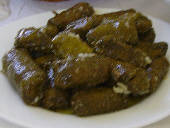n Greek: ντολμαδάκια γιαλαντζί, pronounce dohl-mah-THAHK-yah yah-lahnd-ZEE
Throughout the Middle East and southern Europe, this dish is a favorite. Here in vineyard country, these are often made with the very youngest and tenderest (and smallest) freshly picked leaves – which you can do as well if you have access to vines.
This is the same stuffing I use for stuffed vegetables with rice, so if you don’t want to make 100 pieces, refrigerate the extra filling it and use it for another meal.

Dolmathakia: stuffed grape leaves
Cook Time: 1 hour
Total Time: 1 hour
Ingredients:
- 2 jars of grape leaves in brine (16 oz. jars or about 120-150 leaves)
- 1/2 cup of olive oil
- 1 spring onion, finely chopped
- 1 pound of zucchini, grated
- 1/2 eggplant, peeled and grated
- 2 medium carrots, grated
- 4 ripe tomatoes, peeled, seeded, and chopped
- 1 1/2 cups of long grain rice
- 2 teaspoons of sea salt
- 1 teaspoon of freshly ground pepper
- 1 bunch of fresh parsley, finely chopped
- juice of 3 lemons
Preparation:
Blanch the Grape Leaves
Bring 8 cups of water to a boil in a large pot, add juice of 1/2 lemon and 1 teaspoon of salt. Carefully unroll the leaves (do not separate). Turn off the heat and place leaves in the hot water for 3 minutes. Remove leaves and place them in a bowl and cover with cold water. When cooled, drain in a colander. It is not unusual for many of the outer leaves in the jar or can to be damaged, or to tear while using. Set these aside to use later in the recipe.
Make the Filling
In a large saucepan, heat 1/2 cup of olive oil and sauté the onion for about 2-3 minutes. Add grated zucchini, eggplant, and carrots, and cook over low heat for 10 minutes. Add the tomato pulp and continue to cook for 5 minutes. Remove from the heat and set aside to cool for 15 minutes, and put in a bowl. Add the rice, parsley, remaining salt, and pepper, and mix well with a spoon until blended.
Filling and Rolling the Leaves
Gently separate one leaf and place it shiny side down on a work surface. Cut off the stem and discard. Place one teaspoon of the filling on the leaf at the point where the stem joined the leaf. Fold up the bottom of the leaf over the filling, then each side inward in parallel folds, and roll up the leaf. Roll should be firm, not tight, as the filling will expand during cooking. Repeat until all the filling has been used.
Cooking the Dolmathakia
Because it’s easy for the leaves to burn while the filling cooks, put a plate or wooden souvlaki skewers in the bottom of a heavy-bottomed pot (see tip below). The plate should fit as closely as possible to the sides. If there are unused leaves, or leaves that were torn and not used during the filling process, put them on the plate or on top of the skewers. Place the dolmathakia on top, packing them closely together (not squashed), seam side down, so they don’t unroll during cooking. Layer them until all are in the pot (2-3 layers is best, but no more than 4 layers). Place several unused leaves over the top. Take another plate and place it upside down on top of the dolmathakia, with something to weight it down (I use a second plate). Add 2 cups of water to the pot and cover. Bring the water to a gentle boil, add the remaining lemon juice, reduce heat to low and simmer for approximately 50-70 minutes. Check to see if done. If the rice has cooked, they are done. If not, continue cooking for another 10 minutes and check again. Cooking time depends both on the type of pot used and the particular stovetop element.
If preferred, use a pressure cooker. No plates needed, but do use the skewers in the bottom. Pack the dolmathakia into the pressure cooker, add the 2 cups of water, close and cook for 15-20 minutes at the first pressure mark.
Yield: about 100 pieces
Serving
Individual servings of dolmathakia are 4-5 pieces on small plates as an appetizer, however they can also be used as a side or main dish. Serve dolmathakia warm or at room temperature with avgolemono (egg and lemon sauce), lemon wedges, tzatziki, or unflavored yogurt on the side.
Storage
These will keep well in the refrigerator for about 5 days. Return to room temperature before serving. Drizzle olive oil on top and cover to store. They can also be frozen. If you do freeze, reheat in the microwave or by steaming and serve warm. Don’t just thaw and eat.
Tip
- If you don’t have a plate that fits or skewers, line the bottom of the pan with unused or torn leaves.
